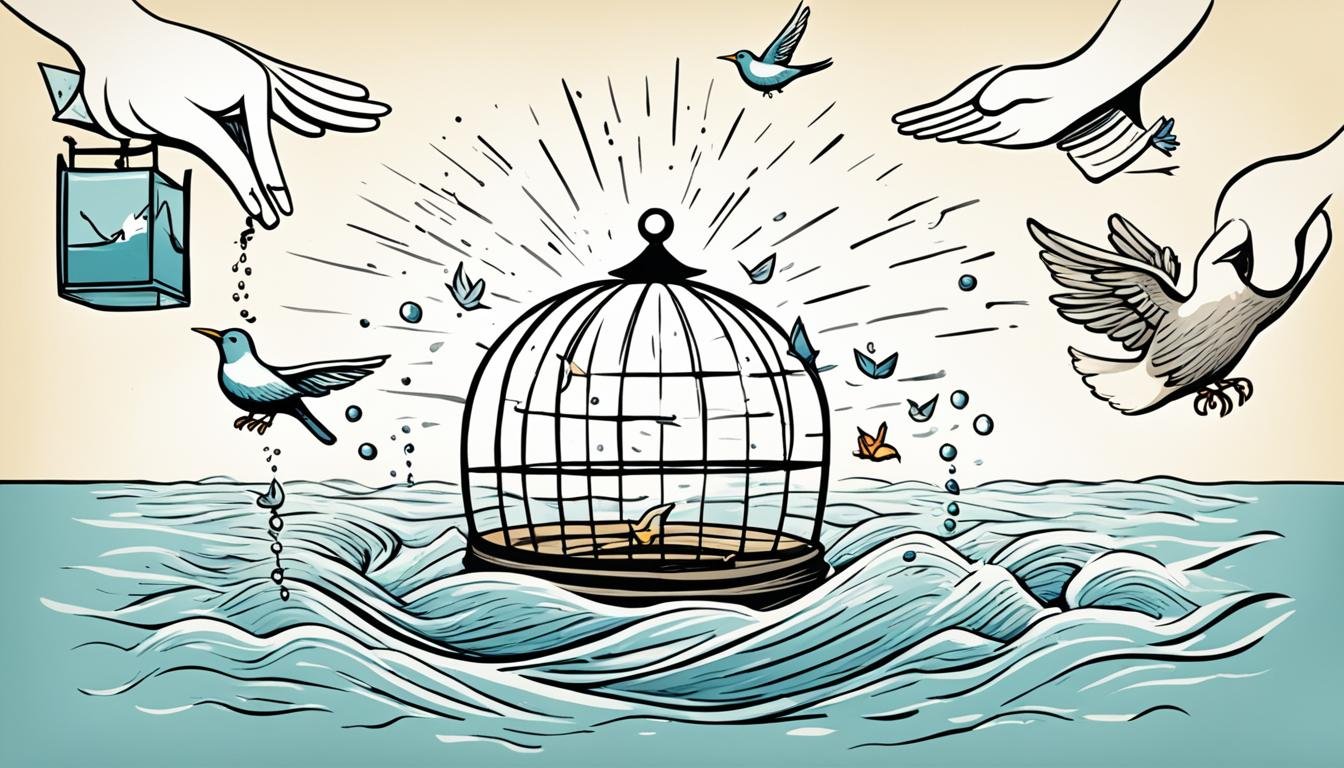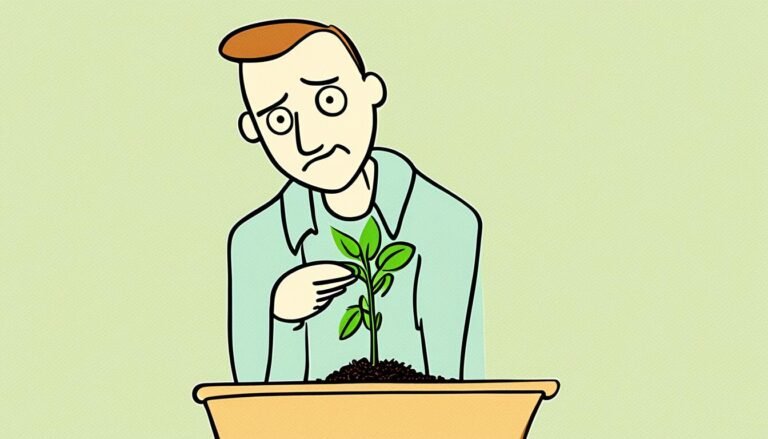The Art of Letting Go: Releasing Attachments and Embracing Detachment
Introduction:
“The truth is, unless you let go, unless you forgive yourself, unless you forgive the situation, unless you realize that the situation is over, you cannot move forward.” – Steve Maraboli
Life is full of experiences, people, and feelings. On this path, we form strong bonds with things, people, and our dreams. These attachments, though comforting at first, can become chains on our happiness. They stop us from growing and lead to a lot of emotional pain.
But letting go means more than just quitting. It’s a choice to drop the weight of what doesn’t help us anymore. This opens the door to new chances, a lighter heart, and peace of mind.
Key Takeaways:
- Letting go is a conscious choice to release attachments that no longer serve us.
- Embracing detachment allows us to move forward and find emotional freedom.
- Releasing attachments can lead to stress relief and a sense of inner peace.
- The art of letting go is a transformative journey towards personal growth and self-discovery.
- Forgiveness is a powerful tool in the process of letting go, enabling emotional healing.
Understanding the Power of Mindfulness
Mindfulness is powerful for letting go. It helps us be aware and accept the present. This makes us let go of what we hold on to. As a result, we find peace inside. It has become very popular recently. This is because it helps a lot with stress and how we feel.
Mindfulness means focusing on now, without judging. We look at our thoughts and feelings without being pulled in. This way, we can understand ourselves and others better. We start to feel calm inside. This brings peace and unity.
It helps us see that things don’t last forever. We start to value what really matters. By doing this, we are happier with our lives. Mindfulness shows us the beauty of what’s around us.
Think of sitting calmly, just noticing your breath. You feel each breath fully. If your mind drifts, gently bring it back. Your aim is to focus on now. This lowers stress and gives you clarity. You start to feel peaceful inside.
Mindfulness unlocks peace inside us. It helps us avoid stress and see the good in every moment. We let go of things that hold us back. This brings true freedom.
Studies show mindfulness is really good for us. It reduces stress and helps us focus better. It makes us aware of ourselves. And we just feel good overall. By doing mindfulness every day, we get in touch with our hearts. We become thankful for what we have and kind to others.
The Power of Mindfulness in Daily Life
- Begin your day by reflecting quietly or doing a short meditation.
- Be present in everything you do, like eating or walking. Notice every detail in the moment.
- Stop during the day to relax. Breathe deeply to let go of stress.
- Watch your thoughts and feelings without judging. Always return your focus to the now.
- When talking to friends, listen carefully without thinking ahead.
Mindfulness changes how we interact with everything. Making it part of our life reduces stress. It brings us peace and happiness.
The Relationship Between Emotional Intelligence and Letting Go
Emotional intelligence matters a lot when learning to let go. It’s about understanding our feelings and how they affect our thoughts and actions. And it’s also about being able to relate to others. This skill helps in managing our emotions and navigating through different social scenes.
Letting go and emotional intelligence go hand in hand. By boosting their emotional smarts, people can leave behind bad feelings, ties, and habits. This happens through understanding oneself and controlling their reactions. They then know when it’s time to move on from things that don’t help them anymore.
Getting a grip on emotions is crucial for growing personally. With emotional intelligence, people are better positioned to face tough times and let go of past hurts. This also helps them in creating better relationships with others. Letting go is key for tossing away old harm that stops progress.
“Emotional intelligence expands our capacity to let go by providing us with the awareness and skills necessary for emotional regulation and personal growth.” – Daniel Goleman
Adding emotional intelligence to letting go leads to deep personal growth. It lets people dive into their feelings and understand themselves better. This awareness starts a journey towards personal change and welcoming new, healthier ways to cope.
The Benefits of Emotional Intelligence in Letting Go:
- Enhanced self-awareness enables individuals to recognize the need for letting go.
- Emotional regulation skills facilitate the process of releasing attachments and negative emotions.
- Increased empathy and understanding of others foster healthier relationships.
- Improved problem-solving abilities lead to more effective decision-making when it comes to letting go.
- Developing emotional intelligence provides a foundation for overall well-being and emotional freedom.
Emotional intelligence gives the power to deal with old grudges, let go of what ties us back, and grow. With this skill, people can let go smoothly and reach a point where they are truly free from past emotional burdens.
Cultivating Self-Acceptance in the Letting Go Process
Self-acceptance is key to letting go. Embracing who we are makes it easier to drop what holds us back. This way, we can move forward, grow, and be emotionally free.
Letting go starts with understanding and accepting our feelings and beliefs. When we’re kind to ourselves, we can begin to love ourselves fully. This brings peace and self-acceptance.
Mindfulness is a great method for self-acceptance. By being curious and kind to our thoughts and feelings, we learn about ourselves. This helps us let go of harsh judgments and lets self-acceptance grow.
“The most powerful relationship you will ever have is the relationship with yourself.” – Diane von Furstenberg
Self-acceptance means ditching what society tells us to be and being true to ourselves. It’s about valuing our unique traits and letting go of the need for others’ approval. This shift lets us concentrate on our growth and freedom.
Getting good at letting go brings self-acceptance. It helps us face our fears, deal with our past, and be at peace with now. When we fully accept ourselves, we grow and transform.
“Authenticity is the daily practice of letting go of who we think we’re supposed to be and embracing who we are.” – Brené Brown
Self-acceptance makes us strong and sure of ourselves in life’s ups and downs. It allows us to make choices that are true to who we are. This helps us achieve emotional freedom and grow personally.
Self-acceptance and letting go are linked with personal growth and freedom. By doing both, we start an important journey. It’s a journey to knowing and loving ourselves deeply, and finding peace within.
Techniques for Embracing Non-Attachment
Non-attachment leads to feeling emotionally free and less stress. By not being too tied to outcomes, things, or people, we feel more peaceful and strong. Here are steps to help you master non-attachment:
1. Practice mindfulness
Being mindful lets us watch our thoughts and feelings without being too involved. This distance helps us see the bigger picture. It stops us from worrying too much about the future or feeling regret about the past. This way, we feel less stressed and more at peace.
2. Cultivate self-awareness
It’s important to know ourselves well to let go of harmful attachments. When we understand what triggers our attachment, we can make a choice. This choice is to let go, helping us move forward with less baggage.
3. Practice gratitude
Gratitude changes our focus from what’s missing to what’s already there. By being thankful for what we have, we feel more fulfilled. This gratitude makes us want less and not overly chase after approval from others.
“The art of non-attachment is the art of living freely, without being bound by the expectations and attachments that weigh us down.” – Unknown
4. Release control
Letting go of wanting to control everything is vital in non-attachment. We must accept that some things can’t be changed. This acceptance helps us flow with life’s changes and welcome new experiences.
5. Engage in self-reflection
Regularly looking at ourselves helps spot clinging we might not notice. Asking certain questions, like “What am I scared to lose?” or “What keeps me attached?” reveals hidden attachments. This process helps us slowly let go.
- Journaling
- Meditation
- Therapy
- Seeking supportive communities
Remember, mastering non-attachment takes time. Be patient with yourself as you practice letting go. Soon, you will feel freer, calmer, and happier.
The Healing Power of Forgiveness
Few things are as powerful as forgiveness. It can heal both us and others. Forgiveness frees us emotionally. It lets us leave resentment behind, moving on with a lighter heart.
Forgiving oneself might be the hardest part. We often hold onto past mistakes too tightly. This can lead to self-blame and guilt. But practicing self-forgiveness brings self-compassion and growth. It helps us build a positive self-image and leaves the past behind.
Forgiving others liberates us from negative feelings that bind us. Anger and grudges hold us back, blocking joy. Choosing to forgive unlocks healing and growth. Forgiveness is a pathway to self-care, not about forgetting or excusing past actions.
“Forgiveness is not an occasional act; it is a constant attitude.”
– Martin Luther King Jr.
Forgiveness sets us free, paving the way for love and understanding to thrive. It’s a daily practice leading to emotional freedom. It welcomes new opportunities and a more joyful life.
Harnessing the Power of Forgiveness
To benefit from forgiveness, follow these steps:
- Reflect on past hurts and their impacts on you. This is a key first step.
- Realize the past can’t change. Letting go of resentment is crucial.
- Empathize with those you need to forgive. Everyone makes mistakes.
- Let go of negative feelings through journaling or talking things out.
- Remember, setting boundaries is vital for your well-being.
- Decide to forgive. Writing a letter of forgiveness can help.
Forgiveness is a journey, taking time and effort. But it leads to letting go of the past and finding a brighter future.
Nurturing Inner Peace Through Letting Go
Letting go means more than just saying goodbye to something. It leads us on a journey to find peace within. By choosing to let go, we can feel calm and free of emotional weightEmotional Freedom. We seek inner peace in a world full of noise by learning to release what holds us back.
By releasing what we’re attached to, we stop holding onto stress. This lets us find deep peaceEmotional Freedom. We understand we can’t control everything. This allows peace to flow into our lives.
Letting go is a change of view, a way to detach from things that don’t help us. It means to let go of anger and pain. This clears space for love and understanding to grow insideLetting Go. It helps us leave the past behind, forgive, and find emotional freedom.
“Letting go gives us freedom, and freedom is the only condition for happiness.”
– Thich Nhat Hanh
Letting go helps us find peace in our daily moments. We stop being trapped by the past or the future. This lets us enjoy calm and happiness.
Letting things go is hard, but it’s bravery, self-growth, and accepting change. It’s a journey to inner peace, love, and joyLetting Go. Embracing it allows us to find the peace we all long for.
The Journey of Personal Growth Through Letting Go
Letting go leads to being free emotionally. It’s a journey that helps us grow and find ourselves. It lets us let go of what holds us back and find our real self.
It takes courage to let go. You have to look inside yourself. This means saying goodbye to things like bad friendships, harmful thoughts, or wrong ideas about who you are. By doing this, we make room for better things.
Letting go means leaving what’s familiar and heading into new areas. It’s about facing fears and dealing with big changes. This can be tough, but it’s how we become stronger and better at handling life’s ups and downs.
The Power of Vulnerability
When we let go, we become open and less controlling. This way, we learn to bounce back from tough times and understand others better. Being open let us grow and feel more free.
“When we let go of trying to control everything, we open ourselves up to new possibilities and experiences.” – Unknown
Not holding on to things from the past means we find ourselves. We get to try new things and see life in different ways. Letting go helps us find strengths we didn’t know we had.
Letting go isn’t quick or easy. It needs us to be patient and kind to ourselves. As we let go of what no longer helps, we make way for a life that’s true to who we really are. This kind of life is full of happiness, a sense of purpose, and being truly free.
Letting go starts a life-long journey. We open doors to unlimited possibilities. So, go ahead, take that first step, and start your own journey to finding your true self. This step will lead to growth and freedom.
Letting Go: A Path to Stress Relief
When life gets too much and stress affects us, finding ways to reduce stress is key. Letting go is one powerful method to help find relief.
Letting go means lessening our attachments and welcoming a mindset of detachment. It’s about not being too fixated on the outcomes and situations. This makes room for inner peace and a feeling of freedom.
By letting go of the need to control all, we feel more at peace. Surrender to life’s flow lets us find deep calm and serenity from within.
The practice shifts our focus. It helps us detach from harmful emotions and worries. This lets us face struggles with more understanding and resilience.
Mindfulness is a great way to let go. It’s about being aware of the current moment, without judging our thoughts and emotions. This brings about clarity and a reduced impact of stressors.
As Eckhart Tolle said, “Some changes look negative on the surface, but you’ll see they make way for something new.”
Letting go doesn’t mean slacking off or ignoring our dreams. It’s about working on our goals, while knowing we can’t control everything. This helps us deal with our limits and embrace our flaws.
As we give up the need for total control and reduce our attachments, we find freedom. We learn to adapt to changes with peace, even when life throws us off balance.
The Benefits of Letting Go:
- Reduces anxiety and stress levels
- Promotes mental and emotional well-being
- Fosters healthier relationships
- Enhances problem-solving skills
- Increases overall resilience
Bringing the art of letting go into our daily routine can really change how we deal with stress. It helps us counter stress with detachment, leading to peace and freedom.
The Art of Letting Go and Finding Happiness
Letting go is the key to true happiness and freedom. It’s about making room in our lives. This space is for joy, peace, and living fully.
When we hold on to what’s run its course, we block our happiness. We may fear the loss of something dear. But, real joy comes from letting go, not holding tight to the past.
Detachment helps us find happiness within ourselves. It stops our chase for things and others’ approval. Instead, it focuses us on what’s truly important. That’s our well-being, growth, and deep connections.
“Happiness is not something ready-made. It comes from your own actions.” – Dalai Lama
The journey of letting go begins with self-awareness and a commitment to our own happiness.
By giving up control, we invite new and amazing things into our lives. We start to trust life’s natural path. Letting go helps us change, grow, and become truly fulfilled.
Letting go isn’t about hiding from our feelings or life’s challenges. It’s about facing them, learning, and moving on. This brings us a lighter heart, true happiness, and peace.
Key Takeaways
- Letting go is a catalyst for finding happiness and emotional freedom.
- Embracing detachment enables us to focus on what truly matters.
- Self-reflection, acceptance, and the willingness to release control are crucial in the letting go process.
- Letting go opens doors to new opportunities and personal growth.
- The art of letting go leads to lasting happiness and inner peace.
Conclusion
Mastering the art of letting go is key to emotional freedom and less stress. By losing attachments and learning to detach, we find inner peace and grow. Letting go breaks past chains, letting us live fully now and create a brighter future.
Mindfulness, emotional intelligence, and self-acceptance help us drop what doesn’t help. This lets forgiveness, healing, and peace in. Letting go starts our journey to find ourselves and grow personally.
Letting go isn’t easy, but its rewards are huge. Releasing attachments cuts stress, giving us freedom to enjoy life. So, let’s embrace letting go and discover the endless possibilities within us.








